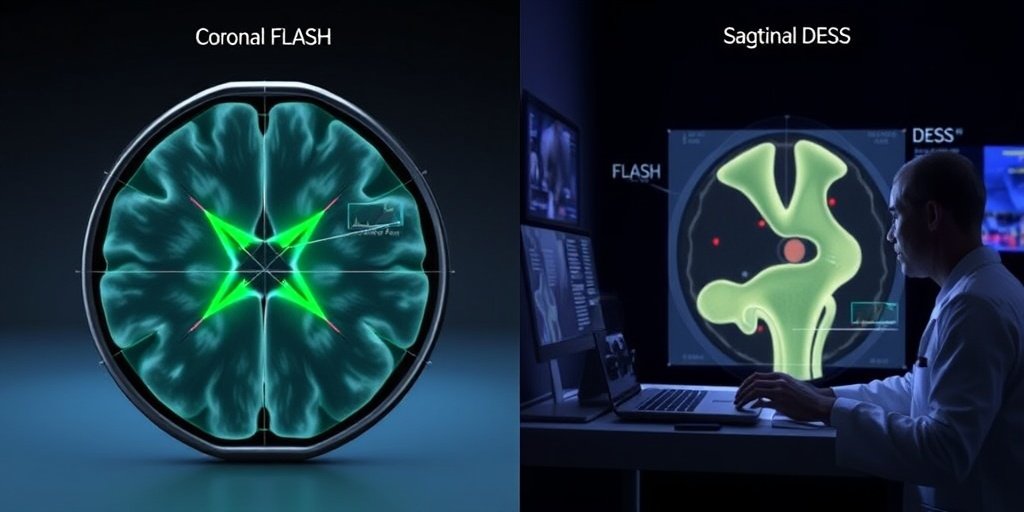⚡ Quick Summary
This study compared coronal FLASH and sagittal DESS MRI in detecting changes in cartilage thickness using fully automated segmentation. The findings suggest that coronal FLASH is at least as effective as sagittal DESS in differentiating between radiographic progressors and non-progressors in osteoarthritis.
🔍 Key Details
- 📊 Dataset: 322 knees from the FNIH biomarker cohort
- 🧩 Features used: Medial and lateral femorotibial cartilage thickness
- ⚙️ Technology: Convolutional Neural Networks (CNN) for automated segmentation
- 🏆 Performance metrics: Sensitivity to change: -0.81 for FLASH, -0.74 for automated DESS, -0.72 for manual DESS
🔑 Key Takeaways
- 🤖 AI-based segmentation shows promise in cartilage analysis.
- 📈 Coronal FLASH MRI is comparable to sagittal DESS in detecting cartilage changes.
- 🔍 Sensitivity to change was highest for FLASH at -0.81.
- 📉 Manual segmentation remains slightly superior in performance.
- 🌐 Study conducted using data from the Foundation of the NIH Biomarker sample.
- 🆔 ClinicalTrials.gov Identifier: NCT00080171.

📚 Background
Osteoarthritis is a prevalent condition characterized by the degeneration of cartilage, leading to pain and reduced mobility. Accurate assessment of cartilage thickness is crucial for monitoring disease progression and treatment efficacy. Traditional methods often rely on manual segmentation, which can be time-consuming and subject to variability. The advent of AI-based automated analysis offers a promising alternative, potentially enhancing the efficiency and accuracy of cartilage assessments.
🗒️ Study
This study aimed to directly compare the effectiveness of coronal FLASH and sagittal DESS MRI in detecting longitudinal changes in cartilage thickness. Utilizing a sample of 322 knees, researchers employed Convolutional Neural Networks (CNN) trained on expert-segmented images to automate the analysis process. The study included both baseline and two-year follow-up MRIs, focusing on differentiating between radiographic progressors and non-progressors.
📈 Results
The results indicated that the sensitivity to change in medial femorotibial cartilage thickness was highest for the FLASH MRI at -0.81, compared to -0.74 for automatically segmented DESS and -0.72 for manually segmented DESS. Furthermore, the differentiation from non-progressors was also notable, with Cohen’s D values of -0.82 for FLASH, -0.70 for automated DESS, and -0.87 for manual DESS, highlighting the effectiveness of all methods but underscoring the slight edge of manual analysis.
🌍 Impact and Implications
The findings of this study have significant implications for the field of osteoarthritis research and clinical practice. By demonstrating that AI-based automated segmentation can achieve comparable results to traditional methods, this research paves the way for more efficient and standardized assessments of cartilage health. This could lead to improved monitoring of disease progression and treatment outcomes, ultimately enhancing patient care.
🔮 Conclusion
In conclusion, this study highlights the potential of AI-driven technologies in revolutionizing cartilage analysis in osteoarthritis. While fully automated segmentation shows promise, the slight superiority of manual analysis suggests that a hybrid approach may be beneficial. Continued research in this area is essential to refine these technologies and improve their application in clinical settings.
💬 Your comments
What are your thoughts on the use of AI in medical imaging? Do you believe it can significantly improve patient outcomes in osteoarthritis? Let’s discuss! 💬 Leave your thoughts in the comments below or connect with us on social media:
Comparison between coronal FLASH and sagittal double echo steady state MRI in detecting longitudinal cartilage thickness change by fully automated segmentation – Data from the FNIH biomarker cohort.
Abstract
OBJECTIVE: Artificial intelligence (AI-) based automated cartilage analysis demonstrated similar sensitivity to change and only slighty inferior differentiation between radiographic progressors and non-progressors compared with manual segmentation. However, this finding was based on DESS MRI from the Osteoarthritis Initiative (OAI), whereas the vast majority of multicenter clinical trials rely on T1-weighted gradient echo (e.g. FLASH). Here we directly compare fully automated analysis of coronal FLASH vs. sagittal DESS, and vs. manually segmented DESS, in a sample with both FLASH and DESS MRI acquisitions.
DESIGN: Convolutional neural network (CNN) algorithms were trained on 86 radiographically osteoarthritic knees with manual expert segmentation of the medial and lateral femorotibial cartilages (coronal FLASH and sagittal DESS). Post-processing involved automated registration of CNN-based subchondral bone segmentation to reference areas. The models were applied to baseline and two-year follow-up MRIs of radiographic progressor and non-progressor knees in the Foundation of the NIH Biomarker sample of the OAI.
RESULTS: Of the 322 FNIH knees with both FLASH and DESS; 157 were radiographic progressors. Sensitivity to medial femorotibial cartilage thickness change (standardized response mean) in the progressor subcohort was -0.81 for FLASH (automated analysis), -0.74 for automatically, and -0.72 for manually segmented DESS. Differentiation from non-progressors (Cohen’s D) was -0.82. -0.70, and -0.87, respectively.
CONCLUSIONS: Fully automated, AI-based cartilage segmentation with advanced post-processing reveals that coronal FLASH is at least as discriminative between radiographic progressor vs. non-progressor knees as sagittal DESS MRI. Yet, performance of fully automated segmentation is slightly inferior to manual analysis with expert quality control.
TRIAL ID: Clinicaltrials.gov identification: NCT00080171.
Author: [‘Eckstein F’, ‘Chaudhari AS’, ‘Hunter DJ’, ‘Wirth W’]
Journal: Osteoarthr Cartil Open
Citation: Eckstein F, et al. Comparison between coronal FLASH and sagittal double echo steady state MRI in detecting longitudinal cartilage thickness change by fully automated segmentation – Data from the FNIH biomarker cohort. Comparison between coronal FLASH and sagittal double echo steady state MRI in detecting longitudinal cartilage thickness change by fully automated segmentation – Data from the FNIH biomarker cohort. 2025; 7:100657. doi: 10.1016/j.ocarto.2025.100657